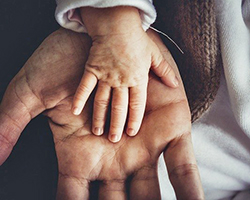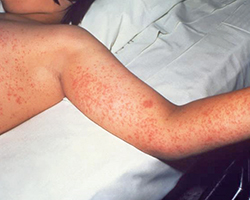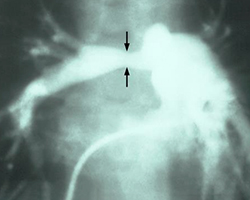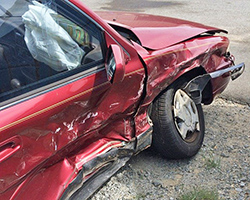Do vaccines scare you?

Have you ever been scared of something you were told was good for you? Think of the first time you entered a new school…maybe that scared you. You may have been nervous to meet new friends, or to sit in a classroom taught by a teacher you didn’t know. That teacher may be mean, or they might be nice. You don’t know. It’s normal to be worried about new things; however, learning about things that are new to us can help us understand them better.
Why are some people against vaccines?
The fear of vaccines actually started early in history. Some people feared the vaccines Edward Jenner was using to protect them against smallpox. This fear arose because people misunderstood how biology worked. In the 18th century, people didn’t even know that germs caused disease.

The smallpox vaccine was first associated with a cow virus, cowpox. People were afraid that if they got the vaccine they would grow cow body parts, or they might even turn into a cow! That might sound strange to us today, but for them the vaccine was scary because it was new and people didn’t know how it worked. Additionally, in reality, smallpox vaccines have been made with cowpox, horsepox, and other poxviruses over time. The history is unclear as to what source was being used for virus when, but many poxviruses were able to provide immunity to smallpox.
Fear of vaccines today
Today most people realize a human won’t just start growing cow (or horse or other animal) parts, but fears about vaccines persist. Some of these fears come from misconceptions about vaccines and their safety. One misconception is that the when babies are born, their immune system cannot handle vaccinations. Though infant immune systems are still developing, they are also very strong. Babies come into contact with many germs in the environment that may make them sick. If a baby were given all 14 scheduled vaccines at once, it would only use up 0.1% of a baby’s immune capacity.
That means that the baby’s system can learn to recognize the inactive germs or pieces of germs given in the vaccine and still have 99.9% of the immune system available to protect the baby from other diseases! However, vaccines are not given immediately after a baby is born.
Why don't babies get vaccinated?

When a baby is born, it inherits antibodies from its mother. These antibodies, called maternal antibodies, are special proteins that can attach to germs and protect the baby from getting sick. But, maternal antibodies can affect the way some vaccines work. This means certain vaccines shouldn’t be given to babies until they are at least a few months old, because they may not work. For example, the measles vaccine uses a weakened germ that the body needs to study. However, if the baby receives the vaccine when it is too young, then the maternal antibodies can kill the weakened germ before the baby’s immune system has a chance to properly study it.
But babies do get vaccinated. Doctors and other medical experts have created a vaccine schedule that recommends which vaccines should be give at what age, and many are in the first year of a child's life. The majority of these are after a baby is two months old or older. Then, as a child grows, they might need to get second or third doses of vaccines to make sure that they remain protected.
Are vaccines safe?
Another misconception is that vaccines contain unsafe toxins. It is true that vaccines can contain ingredients that would be bad at high levels. Formaldehyde, aluminum, or molecules that contain mercury, may be used in some vaccines to help stimulate the immune system (that is, to make it easier for the body to learn from the vaccine), or to better preserve the vaccine.

However, not all vaccines are made with these. For example, thimerosal, a compound that contains mercury, is only used in very specific situations, in flu vaccines that are stored in vials for multiple doses. That ingredient hasn't been used in childhood vaccines since 2001.
For any vaccines that still contain these ingredients, the levels of these chemicals are way below the concentrations which might be a problem. In fact, our own bodies make formaldehyde at higher rates than the rates that are introduced by vaccine. As for aluminum, infants get more aluminum from baby formula or breastmilk than they do from a regular schedule of vaccines. And as for compounds with mercury, there’s roughly the same amount of mercury in a vaccine as there is in a 3-ounce can of tuna, but it's even less harmful than that hints. The types of compounds that contain mercury are very different in a vaccine versus in tuna. Those in a vaccine are MUCH less likely to stay in your body.
Though a lot of people like to point to these toxins as reasons to not get vaccinated, there is no scientific evidence that the low levels of the chemicals used in vaccines are harmful to the human body.
Can vaccines cause autism?
Another major misconception is that vaccines cause autism (they don't). More specifically, some people worry that the MMR (measles, mumps and rubella) vaccine can cause autism (it doesn't). The fear of the MMR vaccine largely began after an article published in the Lancet in 1998 falsely linked the MMR vaccine to autism. When people studied the paper, they found that the author lied about many things in the article. He manipulated the data, misinterpreted results, and did not get proper ethical and clinical approval during the study. The article was discredited, and the author lost his medical license.
Before this article was discredited, however, the media got ahold of it and began publicizing the false link between the MMR vaccine and autism. With the media coverage, fear spread and continues today, even long after the false article was discredited. Vaccines do not cause autism.

Vaccination has become a social issue as well. Some celebrities, like Jenny McCarthy, Jessica Biel, and Jim Carrey seem to be anti-vaccination due to mistaken worries it causes autism. However, other celebrities like Kristen Bell, Jennifer Garner, Jennifer Lopez, and Jon Stewart have spoken out in support of vaccines.
More and more studies are also coming out showing that the MMR vaccine does not cause autism. A 2014 study that gathered information from five other studies on over a million children showed no link between vaccines and autism. Additionally, a 2019 study done on over 650,000 children in Denmark showed that there was no increased risk of autism with vaccination.
So, there’s really nothing to be afraid of. But, if you’re still unsure how you feel about vaccines, it’s important to understand why the benefits of vaccination outweigh any fears you might have. Let’s take a quick look at an example: what can happen if someone isn’t vaccinated for measles, mumps, and rubella (MMR)?
The measles, mumps, and rubella vaccine
The MMR vaccine helps people to avoid severe measles, mumps, and rubella infections. Measles is a scary virus not only because it can make a person very sick but also because it spreads very easily from one person to another. When someone gets measles, they get a high fever (103°F or higher), cough, runny nose, and blue and white spots in the mouth. Then, about two to four days after the initial symptoms, they get a rash which starts at the hairline and spreads down across the whole body.

In severe infections, the patient can get diarrhea, ear infection, pneumonia, and possibly brain inflammation (encephalitis, which is really bad, but luckily really rare, less than 0.1%). By getting the MMR vaccine (or another measles-containing virus), people and children can protect themselves from getting measles. For herd immunity to work, 92-94% of the population needs to be vaccinated.
Currently in the United States, 95% of people, on average, are vaccinated against measles. However, in some communities where these numbers weren’t met, there have been measles outbreaks in recent years. In 2019, nearly 1,300 cases of measles surfaced across 31 states, and it is more likely to spread in areas where many people are unvaccinated. This means that everyone needs to do their part to protect themselves and others from getting measles.
Mumps is also a dangerous disease that can have bad complications. After getting infected, it usually takes two weeks or so for the symptoms to appear. Symptoms of a mumps infection include low fever, headache, loss of appetite, and a general feeling of being sick. Thirty to 40% of people with mumps will also get inflammation of the salivary glands. While symptoms usually go away after 7-10 days, complications can include inflammation of the covering of the brain called the meninges (meningitis), swelling of the testes, and deafness. The mortality rate of mumps is approximately 150-250 deaths per million reported cases, so death can result from this infection as well. 1In order to prevent this infection, 75-86% of the population would need to be vaccinated. In 2016 and again in 2017, over 6,000 cases of mumps were reported in the US, so outbreaks still do occur.

Lastly, we have rubella. The symptoms from rubella begin about two weeks after infection, similar to the other two viruses. Symptoms are mild, patients may have a rash which lasts about 3 days, as well as enlarged lymph nodes that can show up a week before the rash and last several weeks. Encephalitis (inflammation of the brain) also occurs in 1 out of 6,000 cases. If a pregnant woman gets rubella, it can cause something called congenital rubella syndrome (CRS). This syndrome is the most serious risk of rubella as it leads to birth defects or death in the fetuses of pregnant women. CRS can cause deafness, cataracts, heart defects, microcephaly (abnormally small head), reduced mental abilities, bone alterations, and liver and spleen damage.
The mortality rate for rubella was reported at 503 deaths per million reported cases. To protect against this infection with herd immunity, 83-85% of the population must be vaccinated.These numbers are generally met, so in the US, we only have a small number of rubella cases each year, about 10 or less; these are usually people who travelled to other countries and were exposed there. The fact that it still occurs means it is still very important that children are vaccinated for rubella.
All the above infections come with a risk of death or serious problems. These are the reasons the MMR vaccine was made, to prevent the suffering and death as a result of infection. The only risk of getting this vaccine is if someone has an allergic reaction, which only occurs in an estimated 1 in a million doses.
Problem vaccines
Historically, there have been a handful of situations where an approved vaccine later had to be recalled due to safety concerns. This happened in America with a batch of the polio vaccine, and it happened in the 1990s in Japan with a specific type of MMR vaccine.
In cases where a vaccine is pulled, it is because the small fraction of risk from a vaccine has become larger than normal. Let's take Japan as an example. In 2012, Japan stopped providing the triple MMR vaccine and instead started to provide individual vaccines. There were health problems associated with the specific viral strain that was included in their MMR vaccine. The Japanese MMR was made in Japan, using Japanese strains of rubella. This was a very different vaccine than the ones used widely across other areas of the globe.
The Japanese MMR vaccine was pulled, as it should have been, due to increased risk. Because of that, thousands of people get measles in Japan every year. In the first six weeks of 2019, there were over 9,000 reported cases of measles. And 146 people had died in that same time. A case like this puts the levels of risk into perspective. Usually, the risk of a vaccine is about 1 problem in 100,000 to 200,000 patients who receive a vaccine. In Japan, this had grown to well over 1 in 900 patients. That's more than a 0.1% level of risk, versus the normal 0.0007% risk.

How can we compare that risk with something more familiar? In Ontario, Canada, one of the safest cities to drive in in North America, the risk of a fatal crash in 2018 was 6 in 100,000 people licensed to drive. The chance of injury was about 491 in 100,000. Those risks are 0.006% and 0.49%, respectively. That is much greater than the risk of injury from an approved vaccine, which is 0.0007%. Every day, getting into your car for a drive puts you at a much greater risk of injury than getting vaccinated.
Vaccine Side-effects
This isn't to say that vaccines have no effect on our bodies except for immune system training. Part of that training requires an immune response. When you get vaccinated, you may have swelling or soreness where you got your shot. Your tissue can get a little damaged by the injection of fluid, your body works to heal the small cut created by the needle, and a local immune response happens at the same spot. All of these things requires the movement of more cells into the area, which can cause inflammation or swelling. In the case of certain vaccines, like weakened live vaccines, or recombinant vaccines, your body does also fight off a virus. So sometimes you may have signs of illness after specific vaccines. All of these effects are a part of helping you avoid severe disease.
Vaccines are made to save lives
Vaccines are made to save lives. Hopefully, with knowledge comes freedom from fear. Spread the word to others you know who may not understand the risks of not getting vaccinated. It could save their lives.
AMANNA, I., SLIFKA, M. K., (2005) Public Fear of Vaccination: Separating Fact from Fiction. Viral Immunology. 18 (2) 307–315
https://www.publichealth.org/public-awareness/understanding-vaccines/vac...
https://www.ncbi.nlm.nih.gov/pmc/articles/PMC6062137/
Vally, H. What is herd immunity and how many people need to be vaccinated to protect a community? The Conversation. https://theconversation.com/what-is-herd-immunity-and-how-many-people-ne...
Healthychildren.org. MMR Vaccine: What You Need to Know (VIS). https://www.healthychildren.org/English/safety-prevention/immunizations/...
https://www.chop.edu/centers-programs/vaccine-education-center/video/the...
https://www.chop.edu/centers-programs/vaccine-education-center/vaccine-i...
https://www.fda.gov/vaccines-blood-biologics/safety-availability-biologi...
https://www.sciencedirect.com/science/article/pii/S0264410X14006367
https://www.acpjournals.org/doi/10.7326/M18-2101
https://www.thelancet.com/journals/lancet/article/PIIS0140-6736(04)16715-9/fulltext#%20
https://pubmed.ncbi.nlm.nih.gov/8741307/
https://www.vaccineconfidence.org/latest-news/japan-why-japan-banned-mmr...
Read more about: Vaccine science
Bibliographic details:
- Article: Do vaccines scare you?
- Author(s): Dr. Biology
- Publisher: Arizona State University School of Life Sciences Ask A Biologist
- Site name: ASU - Ask A Biologist
- Date published:
- Date accessed:
- Link: https://askabiologist.asu.edu/antivaxxers
APA Style
Dr. Biology. (). Do vaccines scare you?. ASU - Ask A Biologist. Retrieved from https://askabiologist.asu.edu/antivaxxers
Chicago Manual of Style
Dr. Biology. "Do vaccines scare you?". ASU - Ask A Biologist. . https://askabiologist.asu.edu/antivaxxers
Dr. Biology. "Do vaccines scare you?". ASU - Ask A Biologist. . ASU - Ask A Biologist, Web. https://askabiologist.asu.edu/antivaxxers
MLA 2017 Style

Fear of vaccines isn't new. It has been around since the first vaccine was invented. But why are people afraid of something that is designed to help keep them safe? Illustration by Clay Rodery.
Try our COVID simulator to experiment with different safety measures.
Be Part of
Ask A Biologist
By volunteering, or simply sending us feedback on the site. Scientists, teachers, writers, illustrators, and translators are all important to the program. If you are interested in helping with the website we have a Volunteers page to get the process started.

